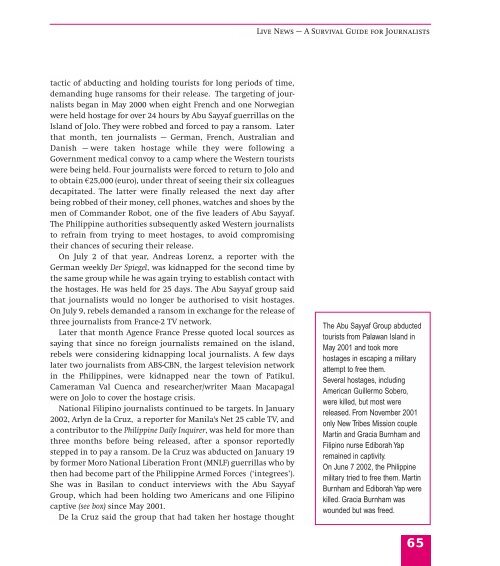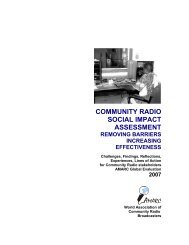Live News - A Survival Guide - International Federation of Journalists
Live News - A Survival Guide - International Federation of Journalists
Live News - A Survival Guide - International Federation of Journalists
- No tags were found...
Create successful ePaper yourself
Turn your PDF publications into a flip-book with our unique Google optimized e-Paper software.
<strong>Live</strong> <strong>News</strong> — A <strong>Survival</strong> <strong>Guide</strong> for <strong>Journalists</strong>tactic <strong>of</strong> abducting and holding tourists for long periods <strong>of</strong> time,demanding huge ransoms for their release. The targeting <strong>of</strong> journalistsbegan in May 2000 when eight French and one Norwegianwere held hostage for over 24 hours by Abu Sayyaf guerrillas on theIsland <strong>of</strong> Jolo. They were robbed and forced to pay a ransom. Laterthat month, ten journalists — German, French, Australian andDanish — were taken hostage while they were following aGovernment medical convoy to a camp where the Western touristswere being held. Four journalists were forced to return to Jolo andto obtain €25,000 (euro), under threat <strong>of</strong> seeing their six colleaguesdecapitated. The latter were finally released the next day afterbeing robbed <strong>of</strong> their money, cell phones, watches and shoes by themen <strong>of</strong> Commander Robot, one <strong>of</strong> the five leaders <strong>of</strong> Abu Sayyaf.The Philippine authorities subsequently asked Western journaliststo refrain from trying to meet hostages, to avoid compromisingtheir chances <strong>of</strong> securing their release.On July 2 <strong>of</strong> that year, Andreas Lorenz, a reporter with theGerman weekly Der Spiegel, was kidnapped for the second time bythe same group while he was again trying to establish contact withthe hostages. He was held for 25 days. The Abu Sayyaf group saidthat journalists would no longer be authorised to visit hostages.On July 9, rebels demanded a ransom in exchange for the release <strong>of</strong>three journalists from France-2 TV network.Later that month Agence France Presse quoted local sources assaying that since no foreign journalists remained on the island,rebels were considering kidnapping local journalists. A few dayslater two journalists from ABS-CBN, the largest television networkin the Philippines, were kidnapped near the town <strong>of</strong> Patikul.Cameraman Val Cuenca and researcher/writer Maan Macapagalwere on Jolo to cover the hostage crisis.National Filipino journalists continued to be targets. In January2002, Arlyn de la Cruz, a reporter for Manila's Net 25 cable TV, anda contributor to the Philippine Daily Inquirer, was held for more thanthree months before being released, after a sponsor reportedlystepped in to pay a ransom. De la Cruz was abducted on January 19by former Moro National Liberation Front (MNLF) guerrillas who bythen had become part <strong>of</strong> the Philippine Armed Forces (‘integrees’).She was in Basilan to conduct interviews with the Abu SayyafGroup, which had been holding two Americans and one Filipinocaptive (see box) since May 2001.De la Cruz said the group that had taken her hostage thoughtThe Abu Sayyaf Group abductedtourists from Palawan Island inMay 2001 and took morehostages in escaping a militaryattempt to free them.Several hostages, includingAmerican Guillermo Sobero,were killed, but most werereleased. From November 2001only New Tribes Mission coupleMartin and Gracia Burnham andFilipino nurse Ediborah Yapremained in captivity.On June 7 2002, the Philippinemilitary tried to free them. MartinBurnham and Ediborah Yap werekilled. Gracia Burnham waswounded but was freed.65
















